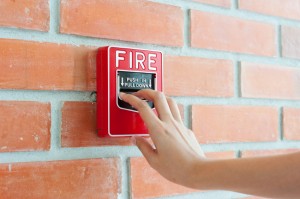
Smoke Alarms
A smoke alarm is a smoke sensing device that sounds an alarm when an abundance of smoke particles are in the air. Some smoke alarms even come with flashing lights for those with hearing impairments. It’s recommended to place a smoke detector on every level of your house—preferably near sleeping areas. There are three types of smoke alarms you can choose from. Howstuffworks.com gives an excellent explanation of how each of these work:- Photoelectric: Uses a light beam and sensor to detect smoke. As smoke travels into a compartment on the detector, that smoke covers the light beam, causing the detector to sound. Better for smoky fires (ex. a mattress or cloth fire).
- Ionization: Uses a chamber to detect an abundance of smoke particles in the air and the accelerated movement of smoke particles signaling an increase of smoke in a room. According to howstuffworks, “This type of smoke detector is more common because it is inexpensive and better at detecting the smaller amounts of smoke produced by flaming fires.”
- Dual Sensor: Contains both Photoelectric and Ionization smoke sensors
Fire Alarms
A fire alarm system can sense heat as well as do everything a smoke detector can. Depending on the type of fire alarm you get and the money you’re willing to pay, a fire alarm can do much more than just signal that there’s a fire in the house. There are several options to choose from that can help you cater to your household. Some optional features of a fire alarm include:- Fire Alarm Control Panel – connects the central monitoring station and all other parts of the system together—like the motherboard of a computer.
- Sprinkler System—automatically activates when smoke particles reach high levels, protects you and property from excessive fire damage (but may cause some water damage as well).
- Warning Systems—alarms, plus visual elements like strobe lights or flashing lights for those who are hearing impaired.
- Fire Alarm Box-a pull down mechanism placed in a glass box that sends out a fire alert to local authorities. Similar to what you see in schools or office buildings.
- Transmitter Devices—optional for elderly, can be worn around neck or as a wristband to signal for help.
Maintenance
Smoke Detectors- Test the detector monthly.
- Replace batteries once a year (if you have a detector that uses a lithium battery do not replace the battery, but replace the whole detector according to the manufacturer’s instructions).
- Replace the detector every 8-10 years.
- If your detector is hardwired to your electrical system, you should have a back-up battery in it as well. Replace the back-up battery once a year.
- The audible components—horn, siren, bell
- The visual components—flashing lights
- The sensors—smoke and fire sensors, sprinkler system
- The signaling system—ability to signal the fire department and local authorities of fire
- The battery—checking for corrosion

3 comments
james crall
Very Nice blog. Explained very well about the difference between Smoke Detectors and Fire Alarms. Keep on sharing
treasure detectors australia
Great Difference between Smoke Detectors and Fire Alarms in your blog….
treasure detectors australia
The T4.2RS can also be upgraded as your skills improve and budget allows with the full line of Factory Team T4 hop-ups, as well as Reedy and LRP performance parts. Drive a genuine Team Associated T4.2RS RTR to the winner’s circle today, or chances are you’ll just be chasing one.